Celebrate Poetry Through Science Content: 3 Easy Lessons
by Carol I. Bearse
 For the past 30 years I have been an ESL teacher, a literacy specialist, a dual language coordinator, a poet-in-residence, and a university professor. While working in these roles, I have used poetry as a vehicle to enrich the vocabulary and observation skills of my English language learners. The new emphasis on the Common Core State Standards has renewed the focus on teaching rich vocabulary, close reading, and analytical skills; poetry lends itself to work within units of study that integrate science and the arts.
For the past 30 years I have been an ESL teacher, a literacy specialist, a dual language coordinator, a poet-in-residence, and a university professor. While working in these roles, I have used poetry as a vehicle to enrich the vocabulary and observation skills of my English language learners. The new emphasis on the Common Core State Standards has renewed the focus on teaching rich vocabulary, close reading, and analytical skills; poetry lends itself to work within units of study that integrate science and the arts.
I have used the following three lessons with intermediate ELs as well as mainstream students. The lessons revolve around animal studies, ocean studies, and botany, but can be used in any area of science study. Depending on the grade level, all lessons can be adjusted for length and requirements.
Assessment
Here is a simple rubric that can be applied to these lessons. For different levels of language learners, the rubric can be adjusted and individualized without losing the science content:
Science Content: 5 specific details, 5 related facts; 10 line minimum
Figurative language: 2 metaphors or similes, and 2 uses of personification
Rhythm: Use of repeating line and/or repeating sounds
Word Choice: 3 vivid verbs, 3 specific nouns, 3 specific adjectives
Mechanics: Spelling and punctuation
Getting Started
These kinds of lessons are best used within units of study where students can research their favorite topics. Brainstorming vocabulary on large wall charts or classifying vocabulary using index cards are ideal ways to begin a lesson. Use of photos, paintings, and video add to the background knowledge of students as well.
I have found it best to teach one or two elements of poetry at a time and then introduce a specific pattern that could be based on a model poem. Modeling this poem several times is crucial to success.
The Poems
Riddle Poems
A kind of simple seven-line poem that students love is a riddle poem based upon science facts. For example, the following poem by a sixth grader describes a sea creature:
My body is flat-shaped (shape of body)
I live on the seabed (where does it live?)
My family’s location is near the coast of South Carolina. (specific location)
My prey includes shrimp, (specific animal’s prey)
Mollusks and other animals.
I have a brassy brown color and a long tail. (color and shape details)
Who am I?
Notice that in this poem each line requires specific science content that guides the students to create a successful writing piece without struggling with an essay or a long research report. This will come later after the students have acquired a strong vocabulary and observational/analytical skills.
Persona Poems
A variation of the above poem can be written as a persona poem. In a persona poem, the poet writes in the first person as though he or she is that object being personified. The same line pattern and requirements can be used.
I am a King Angelfish, known as the
Blue-banded, the king of all angelfish.
I live in the Red Sea.
And also in the Indo-Pacific water.
My colors are white, brown, black, purple, red, and blue.
I only eat small worms and algae.
My gill plate cover with is long spine for protection from predators
I am King Angel, the king of all angelfish.
Learn to Be Poem
One last kind of variation of becoming a scientific object is called a learn to be poem. (McKim & Steinbergh, 1992). Using the same kind of specific language that is gained from content area study, which are mainly Tier 2 and Tier 3 vocabulary words (Beck, McKeown, & Kucan, 2002), learn to be poems are perfect for the science or language arts classroom. Teachers from different disciplines can collaborate and contribute to the knowledge of the content, while the ESL coach or teacher can help with the actual writing of an appropriate pattern.
I have used the poems, “How to Tell a Tornado” by Howard Mohr, “Thirteen Ways of Looking at a Blackbird,” by Wallace Stevens, and “(from) In the Root Cellar” by Maxine Kumin as model poems for this lesson.
Here is an example of a learn to be poem from an eighth grader to get your lesson started:
To Be Seaweed
To be seaweed you have to learn to sway gracefully in the smooth ocean current.
To be seaweed you have to be able to smell of the sweet salty ocean air.
To be seaweed you have to find your wet home to the sandy shore.
To be seaweed you have to feel as slippery as an eel and look like one too.
To be seaweed you have to keep it afloat in Japanese tea.
To be seaweed you have to be grand enough to top the largest and fanciest of all sand castles.
To be seaweed you have to slip away from a young child’s grasp, so as to preserve your life.
To be seaweed you have to learn to keep alive as you are transferred from your outstretching home and be set down in an aquarium.
Remember, poetry is the perfect vehicle for writing in science and for enriching students’ content area vocabulary as well as descriptive language. So, this spring, take a chance with poetry in the content areas. Add spice to your teaching and enjoy.
References
Beck, I., McKeown, M., & Kucan, L. (2002). Bringing words to life: Robust vocabulary instruction. New York: the Guilford Press.
McKim, E. & Steinbergh, J. (1992). 2nd Edition. Beyond Words: Writing Poems with children. Brookline, MA: Talking Stone Press.
______________________________
Carol I. Bearse is an ESL/literacy consultant who has more than 30 years of teaching experience in various contexts. She specializes in integrating the Common Core standards of vocabulary enrichment and reading analysis with the principles of SIOP.
Note: Every effort has been made to contact the copyright holders for permission to reprint borrowed material. We regret any oversights that may have occurred and will rectify them in future printings of this work.
TESOL Blogs
Interested in writing a blog for TESOL?
Contact
Tomiko Breland with your idea or for submission details.
Check out the latest TESOL Blogs:
|
TESOL Convention Blogs
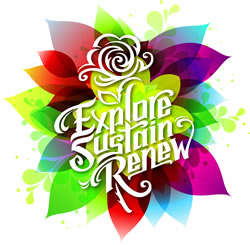 TESOL bloggers keep you up-to-date and posted on what's happening at the 2014 TESOL convention in Portland, Oregon, live! Read about what sessions they're attending, what the hot topics are this year, and what not to miss next year. Read More. TESOL bloggers keep you up-to-date and posted on what's happening at the 2014 TESOL convention in Portland, Oregon, live! Read about what sessions they're attending, what the hot topics are this year, and what not to miss next year. Read More.
|
|
ESL Games: Synonym Lingo Game, by Marc Anderson
 The Game: Synonym Lingo helps to build reading skills and vocabulary. The Game: Synonym Lingo helps to build reading skills and vocabulary.
Research Says: Using this game with ESL students much like other games for vocabulary presentation and revision, according to Agnieszka Uberman in the article “The Use of Games for Vocabulary. Read More. |
|
6 Ideas for Writing in the Real World, by Elena Shvidko
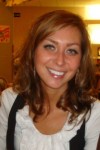 Do your students feel uncomfortable writing in the real world? This is a fair concern, and in fact, I can definitely relate to that—when I started to learn English, I was afraid of making mistakes, which oftentimes made me quite anxious. I eventually overcame this fear with the help of my patient teachers and their authentic assignments that allowed me to practice English beyond the classroom. Do your students feel uncomfortable writing in the real world? This is a fair concern, and in fact, I can definitely relate to that—when I started to learn English, I was afraid of making mistakes, which oftentimes made me quite anxious. I eventually overcame this fear with the help of my patient teachers and their authentic assignments that allowed me to practice English beyond the classroom.
There are a whole variety of strategies and activities that could help your students write outside the classroom. I wanted to share some of them...Read More. |
|
Reflections From TESOL’s First Egyptian President: 10 Accomplishments and Lessons Learned, by Deena Boraie
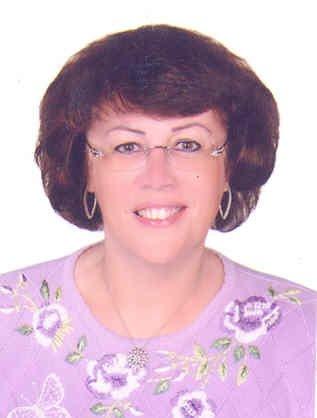 Time has flown—it seems like it was only yesterday when I was installed as TESOL president in Dallas in March 2013. It has been an amazing year! I was extremely busy; I learned a lot, did a lot, and loved it all. I reviewed what I wrote in the summer of 2011 on my election ballot and here are the three things I promised to do back then: Time has flown—it seems like it was only yesterday when I was installed as TESOL president in Dallas in March 2013. It has been an amazing year! I was extremely busy; I learned a lot, did a lot, and loved it all. I reviewed what I wrote in the summer of 2011 on my election ballot and here are the three things I promised to do back then:
- support the development and implementation of powerful professional learning opportunities for all TESOL members in a variety of contexts
- develop relationships and improve communication with all possible partners and organizations in support of TESOL’s efforts
- bridge research and practice to encourage research in TESOL to focus on the kinds of professional knowledge that teachers need.
Read More. |
TESOL Bookstore

Now It’s Easy to Assess Your English Language Learners
TESOL Press Books Can Help
NEW RELEASE! Assessing English Learners in U.S. Schools
Timothy L. Farnsworth and Margaret E. Malone
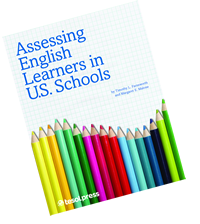 This book views teachers as the people best able to make their students successful. The decisions teachers make about assessments in the areas of literacy, oral language, and content-specific language development result in actionable information. Short reflections, jargon sidebars, and chapter activities make this an enjoyable, user-friendly resource for teachers in any classroom.
This book views teachers as the people best able to make their students successful. The decisions teachers make about assessments in the areas of literacy, oral language, and content-specific language development result in actionable information. Short reflections, jargon sidebars, and chapter activities make this an enjoyable, user-friendly resource for teachers in any classroom.
New Ways of Classroom Assessment, revised
James Dean Brown, Editor
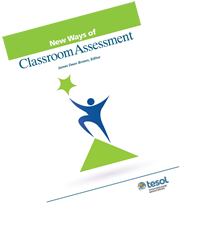 In this revised edition in the popular New Ways Series, teachers contributed activities whose aim was clearly to help their students. Consequently, more than 100 activities enlighten both students and teachers but are thoroughly integrated into the language teaching and learning processes and do not stand out as different, formal, threatening, or interruptive in the classroom.
In this revised edition in the popular New Ways Series, teachers contributed activities whose aim was clearly to help their students. Consequently, more than 100 activities enlighten both students and teachers but are thoroughly integrated into the language teaching and learning processes and do not stand out as different, formal, threatening, or interruptive in the classroom.
Assessment Practices
Christine Coombe and Nancy Hubley, Editors
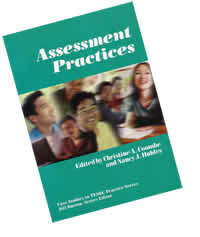 For language educators, teachers, and testers, these studies analyze assessment design, implementation, and review for classrooms, formal tests, programs, curricula, and self-assessment in global scenarios.
For language educators, teachers, and testers, these studies analyze assessment design, implementation, and review for classrooms, formal tests, programs, curricula, and self-assessment in global scenarios.